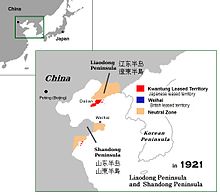Kwantung Leased Territory
| Kwantung Leased Territory | ||||||||||||||
| 關東州 | ||||||||||||||
| Annexed dependency of the Empire of Japan | ||||||||||||||
|
||||||||||||||
|
||||||||||||||
| Capital | Dairen | |||||||||||||
| Languages |
|
|||||||||||||
| Government | Absolute monarchy | |||||||||||||
| Emperor of Japan | ||||||||||||||
| • | 1895 1905–1912 |
Emperor Meiji | ||||||||||||
| • | 1912–1926 | Emperor Taishō | ||||||||||||
| • | 1926–1945 | Emperor Showa | ||||||||||||
| Historical era | Empire of Japan | |||||||||||||
| • | Treaty of Shimonoseki | April 17, 1895 | ||||||||||||
| • | Surrendered | August 14, 1945 | ||||||||||||
| Currency | Japanese yen | |||||||||||||
|
||||||||||||||
| Today part of |
|
|||||||||||||
| Kwantung Leased Territory | |||||||||

Kwantung Leased Territory in 1921. Area of influence and neutral zone.
|
|||||||||
| Chinese name | |||||||||
|---|---|---|---|---|---|---|---|---|---|
| Traditional Chinese | 關東州 | ||||||||
| Simplified Chinese | 关东州 | ||||||||
|
|||||||||
| Japanese name | |||||||||
| Kanji | 関東州 | ||||||||
| Kana | かんとうしゅう | ||||||||
|
|||||||||
| Transcriptions | |
|---|---|
| Standard Mandarin | |
| Hanyu Pinyin | Guāndōng Zhōu |
| Wade–Giles | Kuan1-tung1 Chou1 |
| Transcriptions | |
|---|---|
| Romanization | Kantōshū |
The Kwantung Leased Territory was a territory in the southern part of the Liaodong Peninsula (Japanese: 遼東半島) in the Republic of China that existed from 1898 to 1945. It was one of the numerous territorial concessions that the Qing Dynasty was compelled to award to foreign countries at the end of the 19th century. The territory included the militarily and economically significant ports of Lüshunkou (Port Arthur, Port-Artur in Russian, or Ryojun in Japanese) and Dalian (Dalniy, Dal'nii in Russian, or Dairen in Japanese).
The name Kwantung, or Guāndōng (關東) in pinyin, means "east of Shanhai Pass", a reference to part of Qinhuangdao in today's Hebei province, at the eastern end of the Great Wall of China. The name originally referred to all of Manchuria but later came to be used more narrowly for the area of the leased territory.
In Qing dynasty China, the Liaodong Peninsula was administratively part of Liaoning Province. In 1882, the Beiyang Fleet established a naval base and coaling station at Lüshunkou near the southern end of the peninsula.
The Empire of Japan occupied the region during the First Sino-Japanese War (1894–1895), and under the terms of the Treaty of Shimonoseki signed by Japan and China ending the war in April 1895, Japan gained full sovereignty of the area. However, within weeks, Germany, France and Russia pressured Japan to cede the territory back to China, in what was called the Triple Intervention.
...
Wikipedia


